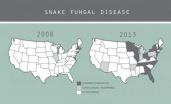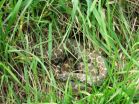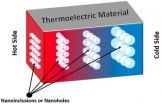(Press-News.org) CHAMPAIGN, Ill. — Researchers have developed a faster and more accurate way to test for infection with Ophidiomyces ophiodiicola, a fungus that is killing snakes in the Midwest and eastern United States. The test also allows scientists to monitor the progression of the infection in living snakes.
The researchers reported on the test at the 2014 Mycological Society of America Annual Meeting.
"We need people to know that they don't have to anesthetize an animal to collect a biopsy sample or, worse yet, euthanize snakes in order to test for the infection," said University of Illinois comparative biosciences department professor Matthew Allender, an expert in snake fungal disease. "Now we can identify the infections earlier, we can intervene earlier and we can potentially increase our success of treatment or therapy."
The new test uses quantitative polymerase chain reaction (qPCR), which amplifies fungal DNA to identify the species present and measure the extent of infection.
Researchers first took notice of Ophidiomyces (oh-FID-ee-oh-my-sees) in snakes in the mid-2000s. Today the fungus threatens the last remaining eastern massasauga (mass-uh-SAW-guh) rattlesnake population in Illinois and has been found to infect timber rattlesnakes, mud snakes, rat snakes, garter snakes, milk snakes, water snakes and racers in several states, Allender said.
"I've tested snakes from Illinois, Tennessee and Michigan, and we've tested samples from snakes in New Jersey, Georgia and Virginia," Allender said. Snakes in Connecticut, Massachusetts, Minnesota, New Hampshire, New York, Ohio and Wisconsin have also tested positive for the fungus. (Watch a movie about the research)
Ophidiomyces consumes keratin, a key ingredient in snake scales. It can cause scabs, nodules, abnormal molting, ulcers and other disfiguring changes to snake skin. Mortality is 100 percent in Illinois massasauga rattlesnakes found with outward signs of infection, Allender said. There are only 100 to 150 massasaugas left in Illinois, he said, and about 15 percent of those are infected with the disease.
Allender also is an affiliate of the Illinois Natural History Survey, part of the Prairie Research Institute at the U. of I. He and his INHS colleague, mycologist Andrew Miller, liken this emerging fungal disease in snakes to white-nose syndrome, another fungal disease that has killed millions of North American bats. Miller and graduate student Daniel Raudabaugh recently published an analysis of Pseudogymnoascus destructans, the fungus implicated in white-nosed syndrome, and are repeating the analysis on Ophidiomyces.
"The fungus killing these snakes is remarkably similar in its basic biology to the fungus that has killed over 6 million bats," Miller said. "It occurs in the soil, seems to grow on a wide variety of substances, and possesses many of the same enzymes that make the bat fungus so deadly."
Other colleagues at the INHS, herpetologists Michael Dreslik and Chris Phillips, have been studying eastern massasauga rattlesnakes in the wild for 15 years, and are working closely with Allender to characterize both biological and health factors that lead to infection. The new qPCR test is integral to this mission, Allender said. It also will help the team develop new therapies to treat infections in snakes.
"This work is truly collaborative across disciplines, allowing the team to make advances in studying this disease that haven't been accomplished anywhere else," Allender said.
"Our qPCR is more than 1,000 times more sensitive than conventional PCR," Allender said. "We can know how many [fungal spores] are in a swab and then we can start to treat the snake and we can watch to see if that number is going down."
The researchers also are hoping to find new disinfectants that will kill the fungus so that researchers who are studying snakes in the wild will not spread it to new locales on their equipment or shoes.
"Some of our preliminary studies show that the common disinfectants that we use are not effective," Allender said. "This fungus overcomes it."
INFORMATION:
The Illinois Wildlife Preservation Fund Grant Program, offered through the Illinois Department of Natural Resources, provided support for this work. Funds for this program are generated through the tax check-off offered on Illinois income tax returns.
Editor's notes: To reach Matthew Allender, call 217-265-0320; email mcallend@illinois.edu.
Scientists gear up to fight deadly snake fungal disease
2014-07-15
ELSE PRESS RELEASES FROM THIS DATE:
This week from AGU: Dust models, Arctic Ocean waves, floods and climate change
2014-07-15
From AGU's blogs: Global climate models fail to simulate key dust characteristics
Climate models that simulate the airborne African dust that influences Atlantic Ocean hurricanes are not up to the task of accurately representing the characteristics of that dust, according to a new study accepted for publication in Geophysical Research Letters.
From AGU's journals: Surface waves contribute to ice retreat in Beaufort Sea
Surface waves, created by blowing wind, play a role in energy and nutrient transport and also shape coasts through erosion. Because the Arctic Ocean ...
New UK study helps scientists understand melanoma development
2014-07-15
LEXINGTON, Ky. (July 15, 2014) — A new study by University of Kentucky researchers shows how a genetic defect in a specific hormonal pathway may make people more susceptible to developing melanoma, the deadliest type of skin cancer.
Fair-skinned people who tend to burn (rather than tan) from sun exposure have a much higher risk for melanoma than darker-skinned people. On the surface, it appears that the amount of melanin, the natural substance in the skin that determines pigment and acts as the skin's "natural sunscreen," would be the only determinant of melanoma risk. ...
Directly visualizing hydrogen bonds
2014-07-15
WASHINGTON D.C., July 15, 2014 – Using a newly developed, ultrafast femtosecond infrared light source, chemists at the University of Chicago have been able to directly visualize the coordinated vibrations between hydrogen-bonded molecules -- the first time this sort of chemical interaction, which is found in nature everywhere at the molecular level, has been directly visualized. They describe their experimental techniques and observations in The Journal of Chemical Physics, from AIP Publishing.
"These two-dimensional infrared spectroscopy techniques provide a new avenue ...
New feathered predatory fossil sheds light on dinosaur flight
2014-07-15
LOS ANGELES—A new raptorial dinosaur fossil with exceptionally long feathers has provided exciting insights into dinosaur flight. A paper published in Nature Communications on July 15, 2014 asserts that the fossil—discovered by an international team led by Natural History Museum of Los Angeles County (NHM) paleontologist Dr. Luis Chiappe—has a long feathered tail that Chiappe and co-authors believe was instrumental for decreasing descent speed and assuring safe landings.
The 125-million-year-old dinosaur, named Changyuraptor yangi, was found in the Liaoning Province ...
New materials for future green tech devices
2014-07-15
WASHINGTON D.C., July 15, 2014 -- From your hot car to your warm laptop, every machine and device in your life wastes a lot of energy through the loss of heat. But thermoelectric devices, which convert heat to electricity and vice versa, can harness that wasted heat, and possibly provide the green tech energy efficiency that's needed for a sustainable future.
Now, a new study shows how porous substances can act as thermoelectric materials—pointing the way for engineering the use of such materials in thermoelectric devices of the future.
About 70 percent of all the energy ...
Widespread support for rapid HIV testing in dental surgeries -- new study
2014-07-15
More than 80 per cent of oral health patients are willing to receive rapid HIV-testing in dental settings, which could help reduce the spread of the HIV according to a groundbreaking study revealed today at a Sydney University HIV Testing Symposium.
The first of its kind study of 521 Sydney-based dental patients assessed patients' willingness to undergo rapid HIV testing in dental settings, their preference for HIV testing-type type and their willingness to pay for the test.
Rapid HIV testing is a screening test that swiftly detects the presence of HIV antibodies in ...
Hear Jane read: Rutgers University-Newark researcher gives new meaning to semantics
2014-07-15
For years a key way of diagnosing dyslexia has been how well a person reads aloud. Similarly, the reading skills of adult readers also have been assessed by having them read words aloud. "The idea is that the more you read in English, the more you will encounter words that don't follow standard rules of pronunciation, so it's an index of reading exposure and, presumably, ability," explains researcher William W. Graves. But are you a better reader if you pronounce a word based on its meaning, or based on its spelling? Does it make a difference? And why? Those are the ...
Genetic testing for alcohol dependence risk in African Americans
2014-07-15
New Rochelle, NY, July 15, 2014—Alcohol dependence (AD) has a genetic component and testing can determine a person's genetic risk for susceptibility to AD. A new study shows that while more than 85% of the African American adults expressed an interest in genetic testing for AD susceptibility, many had ethical, privacy, and procedural concerns, as reported in Genetic Testing and Molecular Biomarkers, a peer-reviewed journal from Mary Ann Liebert, Inc., publishers. The article is available on the Genetic Testing and Molecular Biomarkers website.
Denise Scott and coauthors ...
New statement on 'PEG' feeding tubes in children published by Journal of Pediatric Gastroenterology
2014-07-15
July 15, 2014– Placement of a percutaneous endoscopic gastrostomy tube has become an "essential" technique for children and young people with a wide range of problems with feeding and nutrition, according to a position statement in the Journal of Pediatric Gastroenterology and Nutrition, official journal of the European Society for Paediatric Gastroenterology, Hepatology and Nutrition (ESPGHAN) and the North American Society for Pediatric Gastroenterology, Hepatology and Nutrition. The journal is published by Lippincott Williams & Wilkins, a part of Wolters Kluwer Health. ...
Identifying newly diagnosed HIV-infected people using electronic medical records
2014-07-15
New Rochelle, NY, July 15, 2014—A new, validated software-based method for identifying patients with newly diagnosed HIV using electronic medical records (EMRs) is described in AIDS Research and Human Retroviruses, a peer-reviewed journal published by Mary Ann Liebert, Inc., publishers. The article is available free on the AIDS Research and Human Retroviruses website at http://online.liebertpub.com/doi/full/10.1089/aid.2013.0287 until August 15, 2014.
Providing medical care early on to people with newly diagnosed HIV infection is important for improving clinical outcomes. ...







